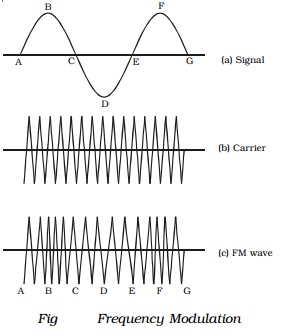Chapter: 11th 12th std standard Class Physics sciense Higher secondary school College Notes
Frequency modulation (FM): Advantages and Disadvantages

Modulation
In radio broadcasting, it is necessary to send
audio frequency signal (eg. music, speech etc.) from a broadcasting station
over great distances to a receiver. The music, speech etc., are converted into
audio signals using a microphone. The energy of a wave increases with
frequency. So, the audio frequency (20 - 20000 Hz) is not having large amount
of energy and cannot be sent over long distances. The radiation of electrical
energy is practicable only at high frequencies e.g. above 20 kHz. The high
frequency signals can be sent through thousands of kilometres with
comparatively small power.
Therefore, if audio signal is to be transmitted
properly, the audio signal must be superimposed on high frequency wave called
carrier. The resultant waves are known as modulated waves and this process is
called as modulation. This high frequency wave (Radio frequency wave) is
transmitted in space through antenna. At the receiver end, the audio signal is
extracted from the modulated wave by the process called demodulation. The audio
signal is then amplified and reproduced into sound by the loud speaker.
A high frequency radio wave is used to carry
the audio signal. On adding the audio signal to carrier, any one of the
characteristics namely amplitude or frequency or phase of the carrier wave is
changed in accordance with the intensity of the audio signal. This process is
known as modulation and may be defined as the process of changing amplitude or
frequency or phase of the carrier wave in accordance with the intensity of the
signal. Some of the modulation process namely,
(i) amplitude modulation,
(ii) frequency modulation and
(iii) phase modulation
Frequency modulation (FM)
When the frequency of carrier wave
is changed in accordance with the intensity of the signal, the process is
called frequency modulation.
In frequency modula-tion, the
amplitude and phase of the carrier wave remains constant. Only, the frequency
of the carrier wave is changed in accordance with the signal.
The frequency variation of the carrier wave depends upon the
instantaneous amplitude of the signal as shown in Fig a. When the signal
voltage is zero at A,C,E and G, the carrier frequency is unchanged. When the
signal approaches its positive peaks at B and F, the carrier frequency is
increased to maximum as shown by closely spaced cycles in Fig c. But during
the negative peak of signal as at D, the carrier frequency is reduced to
minimum as shown by widely spaced cycles in Fig. c. The louder signal
causes greater frequency change in modulated carrier as indicated by increased
bunching and spreading of the waves as compared with relatively weaker signal.

The frequency of an FM transmitter without signal input is
called the resting frequency or centre frequency (fo
) and this is the allotted frequency
of the transmitter. When the signal is applied, the carrier frequency deviates
up and down from its resting value fo.
The change or shift either above or below the resting
frequency is called frequency deviation (∆f). The total variation in frequency from the lowest to the
highest is called carrier swing (CS).
Hence,
Carrier swing = 2 × frequency deviation = 2 × ∆f
For the purposes of FM broadcasts,
it has been internationally agreed to restrict maximum deviation to 75 kHz on
each side of the centre frequency for sounds of maximum loudness.
Advantages
(i)
It gives
noiseless reception. Noise is a form of amplitude variation and a FM receiver
will reject such noise signals.
(ii)The operating range is quite large.
(iii)
The
efficiency of transmission is very high.
Disadvantages
(i)
A much
wider channel is required by FM.
(ii)FM transmitting and receiving equipments tends to be more complex.
Related Topics